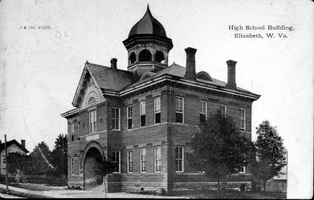 | Back to e-WV
| Back to e-WV
 The West Virginia Encyclopedia
The West Virginia Encyclopedia
 | Back to e-WV
| Back to e-WV
 The West Virginia Encyclopedia
The West Virginia Encyclopedia

Elizabeth is the county seat of Wirt County. William Beauchamp settled there in 1796. Beauchamp farmed 1,400 acres at Tucker’s Riffle on the Little Kanawha River. He had been a sailor in the American Revolution and was a lay preacher in the Methodist Church. In 1817, the town, which earlier had been known as Beauchamp’s Mills, was renamed for Elizabeth Woodland Beauchamp, the wife of William’s son, David. The town was chartered in 1822. Around 1835–40, David and Elizabeth’s son, Alfred Beauchamp, built a brick house which came to be known as the ‘‘Old Red Brick.’’ The first county and circuit courts met in this house when Wirt County was formed in 1848. Now known as the Beauchamp-Newman House, it is listed in the National Register of Historic Places.
William Beauchamp and sons Manlove and David developed grain mills and sawmills, and lumbering is still an important part of the local economy. Elizabeth and Wirt County were beneficiaries of an oil boom when the nearby Burning Springs oil field opened in 1860. Burning Springs was the second oil field in the United States. In 1863, the Confederate Army precipitated the end of the Burning Springs oil boom by destroying the town of Burning Springs and its oil wells.
Located on the Little Kanawha at the junction of State Routes 14, 53, and 5, Elizabeth is the commercial center for a rural region dependent on agriculture, oil, and gas for its economy. Wirt County has the smallest population of the 55 West Virginia counties, and Elizabeth’s population was 724 in 2020, a decline of 27.1 percent in the 21st century.
Read the National Register nomination for the Beauchamp-Newman House.
Written by Gordon L. Swartz III
Puetz, C. J. West Virginia County Maps. Lyndon Station, WI: Thomas Pub..
Reed, Louis. Warning in Appalachia: A Study of Wirt County. Morgantown: West Virginia University Library, 1967.